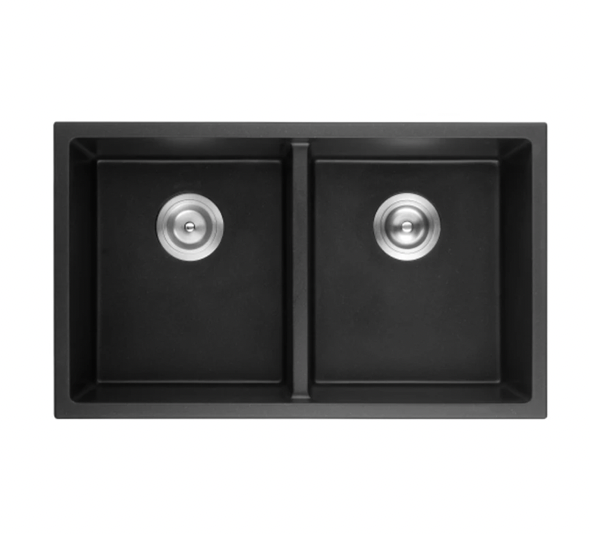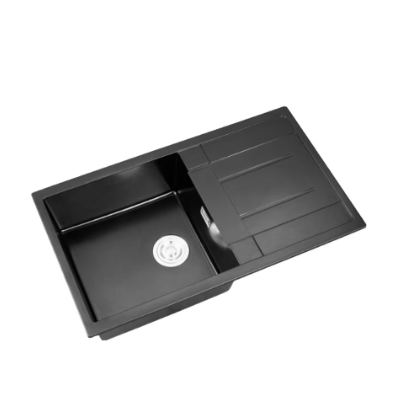Understanding Granite Sink Material Composition
Natural vs. Composite Granite Sinks
Natural granite sinks are cut from natural stone and have a completely natural and classic stone look. These sinks feature the natural beauty and tones of granite, which are blended with an acrylic resin that gives this sink a lustrous finish. By contrast, composite granite sinks are made of a mixture of crushed stone and acrylic resins, and they have a more consistent look. This man made material is resistant to chipping and replicates the exclusive look of granite while adding unbeatable strength and easy cleanability! Appearance-wise, natural granite sinks have their own complex, unique designs, whereas composite sinks have a more finished look. Maintenance is also different, with natural granite sinks needing to be sealed regularly, while those of the composite variety do not. Costwise, composite sinks are cheaper and simpler to place. A 2010 survey has shown that more than 60% of consumers would rather have a granite composite sink, as it is easier to maintain and better looking then natural granite as it will always be the same.
Key Properties: Durability and Heat Resistance
Granite is durable, which is why granite sinks are some of the most popular in the kitchen. Its durable material prevents it from cracking easily under heavy use. Granite also resists heat when used in the kitchen, even resisting damage from hot pots and pans. Industry studies have shown that granite sinks can withstand heat up to 536°F (280°C), allowing you to move directly from the cooktop to your sink with ease. Stamped with the seal of experts, this durability along with the heat resistance makes granite sinks an investment that will stand the test of time in any kitchen.
Non-Porous Surfaces for Hygiene
Granite sinks also provide a hygienic kitchen environment due to the non-porous nature of the material, which prohibits bacteria and mould from growing. Non-porous surfaces (like granite sinks) by nature do not allow for bacteria to grow within tiny crevices, unlike bacteria-prone porous surfaces. Statistical hygiene studies demonstrate that non-porous materials decrease bacteria levels by 80% versus porous surfaces. Hygiene is of utmost importance in food preparation and in the Granite sinks, an easy to clean surface that ensures the highest levels of hygiene.
Evaluating Your Kitchen Needs and Usage Patterns
Single-Basin vs. Double-Basin Functionality
The decision between a single-basin and double-basin sink is largely a function of your cooking style and the needs of your household. Single basin sinks are specially designed for larger pots and large silverware, for those who love to cook big meals or entertain with friends. Meanwhile, double-basin sinks provide flexibility, so you can easily multitask by, for example, washing up in one basin and soaking and prepping vegetables in the other. Double-basin sinks are a favorite among families as they help to create a system of their tasks, streamlining the time they spend in the kitchen. Consumer feedback indicates that a person’s choice between the single and the double set-up may differ here, and their wants and needs will also play a big part in determining which is the best fit.
Optimal Bowl Depth for Daily Tasks
The depth of the bowl has a great effect on the way you can use a kitchen sink, from washing large pots to filling pitchers with water. Standard sink depths are available between 8 to 10 inches and these are suitable to most people in ergonomic studies. Professional chefs tend to swear by deep bowls due to their anti-splash properties and capacity to hold everything needed at a go, making kitchen tasks easier. Therefore, when choosing a sink, make sure to find the depth that works best for your everyday kitchen activities to achieve both practical and comfortable use.
Matching Sink Size to Cabinet Dimensions
When it comes to fitting a new sink, correct sizing is essential to a perfect fit with cabinet measurements. When you choose a sink that’s the wrong size, it can be difficult to install and will look out of place in your bathroom. Normal sink dimensions are usually standard cabinets, which range from 30 to 36 inches in width. You want to make sure you've given yourself enough room for mounting hardware and plumbing connections. Misfit situations, like a sink under which you can see part of the counter or one with little to no edge support, can throw off the cohesiveness of your kitchen design. So, the old adage of measure twice, cut once and listen to what the pros advise, can help ensure that you don't fall into any renovation pitfalls.
Choosing the Right Installation Style
Undermount vs. Top-Mount: Pros and Cons
While choosing the installation type of kitchen sink, both undermount and top-mount styles have their own aesthetic and functional value. "Undermount sinks" are mounted underneath the worktop so the edge of the counter is exposed, and they are held in place from below the counter with screws which is a small detail but results in a very sleek appearance and allows the countertop to be wiped more easily. Top-mount sinks, also called drop-ins, rest on top of the countertop, so they are generally more cost-effective and easier to install.
- Pros of Undermount Sinks: They offer a seamless look, are easy to clean, and pair well with granite countertops.
- Cons of Undermount Sinks: Installation can be complex and may require professional assistance, often leading to higher costs.
- Pros of Top-Mount Sinks: These sinks are easy to install and replace, making them ideal for budget-conscious homeowners.
- Cons of Top-Mount Sinks: They might gather dirt along the rim and can alter the countertop's clean lines.
Market data suggests that undermount sinks are gaining popularity among homeowners due to their aesthetic benefits and compatibility with contemporary kitchen designs.
Farmhouse Sink Considerations
Farmhouse sinks, also known as apron-front sinks, have gained in popularity for their rusty chic style and dependability. Their deep bowls can accommodate oversize pots and pans, which is why they're a popular choice for serious chefs. Though they are visually stunning, the addition of a farmhouse sink can mean a manipulation of countertop height and layout, which may not be ideal for a kitchen space.
- Visual Appeal: Farmhouse sinks offer a unique focal point that complements both traditional and modern kitchen aesthetics.
- Installation Logistics: Requires thoughtful planning to accommodate the sink’s depth and weight, sometimes necessitating custom cabinetry and support for the heavier apron-front design.
For example, kitchens featuring farmhouse sinks commonly integrate with cabinetry and countertops to create a cohesive look, balancing the weight and depth with a sturdy and functional design.
Compatibility with Countertop Edges
DIFFERENT COUNTERTOPS When deciding on a sink installation, please be aware of how the sink choice will be affected by countertop edge options. Various countertop edges, such as beveled or bullnose, will affect how seamlessly the sink can fit within the kitchen aesthetic. **Under mount Fans of the** and polished edges will appreciate the seamless transition from counter to sink, while **Top mount Fans of the** work that fluent pedicure sure, to the beveled edges of the cap edge that is visible to hum.
- Countertop Edge Styles: Designers often recommend polished edges for a seamless look with undermount sinks, while beveled edges complement top-mount designs.
From designers' perspectives, matching sink cutouts with countertop styling is essential. Through careful selection, homeowners can ensure that their sink aligns with both practicality and the desired kitchen look, enhancing the overall design cohesion and functionality.
Stain and Scratch Resistance Ratings
When you decide what type of kitchen sink would be the best choice for your kitchen you think about the stain and scratch. resistance, because is it a product that gets used daily. Granite sinks are usually tested with some quality of parameters in order to check their resistance towards scratches, stains etc. These are often conducted by putting staining agents and abrasive materials onto the sink surface and testing the resistance. The resistance is variable according to the granite mineral composition. The higher content of quartz, for instance, means the more scratch-resistant it typically is. Construction pros say knowledge of these ratings is important for those who design for durability at home in the kitchen. According to industry experts, “A sink that test well continues its beauty over time even after day to day use.
Heat Tolerance for Cooking Needs
A granite sink's heat resistance must be judged to merit the attention of home chefs dealing with hot pans. Granite composite sinks are also resistant to burning and can withstand heat up to 500°F without consequences such as warping or damage. This added plus means that when you set a red-hot pot or pan on the sink to cool, you won’t have to worry about the material experiencing thermal shock. Comparison guides show that stainless steel sinks cool down quickly but can sometimes become warped or stained under extremely high temperatures. Speaking of which, kitchen lovers can attest to the fact that granite sinks are no pushovers, they can be crafted to conform to the user’s cooking habits without losing its strength, which naturally translates to its functionality in a mad and busy kitchen.
Cleaning Requirements for Longevity
Granite sinks will last and look good so long as you clean and maintain them properly. It’s best to clean the surface with just a drop of dish soap and a gentle cloth to protect it against any abrasive damage. Using these products on a regular basis will keep the sink looking like new and prevent water spots and mineral deposits. Failure to maintain can result in stains and dulling the natural luster of the sink over time. In a study conducted by the National Sanitation Foundation, regular cleaning can help ensure the service life of a kitchen appliance (appliances that were taken care of have lasted up to 15 years longer than those that were not). That is why maintaining a disciplined cleaning schedule is necessary to maintain your granite sink to continue its functionality, and of course, to keep on looking beautiful!

Budgeting and Cost-Effectiveness
Price Ranges by Material Quality
It’s important to know the granite sink prices to budget accordingly. Granite composite sinks are usually priced from $400 to $2000 and above, basin configuration are some of the factors that affect the price. A granite sink will generally cost $400 to $1500 for a single-basin model, with high-end models coming in over that. Double basin options range from $600 on the low end to $2000, while farmhouse sinks typically begin at $800 and go up to $2000. It is obvious that quality of the item and design complexity has a lot do with cost. A quality granite composite sink can be an investment with the practical application it delivers for your kitchen; it is also an accessory that has a lot of visual impact, and in many cases can be a make or break addition your kitchen needs.
Balancing Initial Costs with Long-Term Value
Take into account initial cost and long term value when budgeting for a granite sink. The Canon Cable ID printer provides the total cost of ownership including the initial investment, installation, and routine maintenance. Although they are a bit pricier than other types of sink upfront, their longevity and low replacement burden do allow for saving in the end. The smart advice will tell you to go for such durable materials as granite composite, which will defray expenses over time despite the cost. By choosing the right kitchen hardware, such as appliances, accessories and other key design elements, you’ll be able to enjoy your kitchen in the best possible light – and whatever free time you have left will be able to relax in an attractive, tasteful and well-ordered environment.
Warranty and Manufacturer Support
It is advisable to consider warranties and support from the manufacturer when buying kitchen sinks. A strong warranty can offer relief from defects or damage that might happen. Look for full manufacturer support, which may include customer service help, replacement parts and maintenance advice. reading ratings and reviews of a-code manufacturers could help you to determine reliability with confidence. High-rated manufacturer is heavy to be high quality product and excellent customer support so you would purchase such smart kitchen fixtures.
FAQ
What is the main difference between natural and composite granite sinks?
Natural granite sinks are carved from quarried stone, offering unique patterns, while composite granite sinks are made from a blend of crushed stone and acrylic resins, providing a consistent color and appearance.
How durable are granite sinks?
Granite sinks are highly durable, resistant to cracks and chips, and can withstand high temperatures up to 536°F (280°C), making them ideal for heavy kitchen use.
Do granite sinks require a lot of maintenance?
Natural granite sinks require frequent sealing, while composite granite sinks are easier to maintain. Regular cleaning with mild dish soap and a soft cloth helps maintain their appearance and longevity.
What are the benefits of undermount sinks?
Undermount sinks provide a seamless look and easier cleanup, as debris can be swept directly into the sink. However, they may require professional installation, leading to higher installation costs.
Why should I consider a farmhouse sink?
Farmhouse sinks are practical for handling large pots and pans and offer a rustic charm. They may require adjustments to countertop height and custom cabinetry to accommodate their depth and weight.



